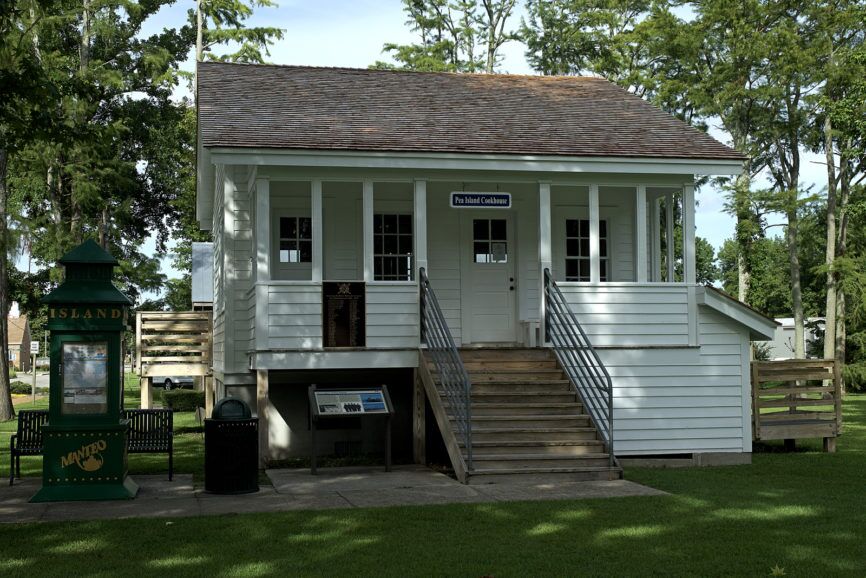Located across Highway 64, the main road through Manteo, the building was at one time the cookhouse for the Pea Island Coast Guard Station, and its history directly leads to the story of the Pea Island Lifesaving Station and the all Black crews that staffed it from 1880 until it closed in 1947.
The cookhouse was built sometime in the 1930s and has been beautifully restored to its original condition.

The first Pea Island Lifesaving Station became operational in 1878 as the Lifesaving Service, the predecessor to the US Coast Guard, expanded its reach following the Outer Banks disasters of the USS Huron off Nags Head in 1877 and the Metropolis that ran aground along the Currituck Banks.
Sumner Kimball, the new General Superintendent of the service, was determined to have a professional lifesaving service and he knew simply building stations was not enough. He understood that standards and rigorous inspections holding stations to those standards would also be needed.
Evidently, the crew of Lifesaving Station No. 16 District 6 didn’t get the memo or didn’t understand that Kimball was adamant that stations would be run professionally.
The M&E Henderson ran aground and sank three miles south of the station. Of the seven crew members, three survived. The captain and three crewmen perished.
According to what Station Keeper George Daniels wrote in his report, surfman Tillett had just returned from a patrol and was scanning the area with the station’s binoculars when he saw what he thought was a fisherman on the beach. Subsequent investigation found it was the three survivors of the M&E Henderson.
A good sounding story and that is what the official report said, but when Lt. Charles Shoemaker investigated, he quickly established that the report was all a lie, that Tillett had not patrolled the beach as he was required to do and that evidence suggested that Station Keeper Daniels was not even at the station when the disaster occurred.
The entire crew was dismissed from service, and Kimball accepted the recommendation of his inspectors that a Surfman #6 Richard Etheridge—the lowest rank—at Bodie Island be promoted to Station Keeper.
It was a radical suggestion for the time. Although there were Black Lifesaving personnel, they were only permitted to hold the lowest rank—surfman #6—at the stations and usually worked as the station cook and cleaner.
But Shoemaker and Kimball’s other inspector, Lt. Frank Newcomb, had both come to the same conclusion.
“I am aware that no colored man holds the position of keeper in the LifeSaving Service…at best such as are surfmen…I am fully convinced that the interests of the LifeSaving Service here in point of efficiency will be greatly advanced by the appointment of to the position of Keepership of Station No. 17.” Shoemaker wrote.
Etheridge was appointed Station Keeper but no white crew would serve with him so Kimball assembled an all Black crew, and the Pea Island Station was staffed by all Black personnel for the next 67 years until it was decommissioned.
The story does not quite end there.
With an all Black crew assigned, someone set fire to the station and it had to be rebuilt in 1881.
The building was renovated over the years, but no longer exists. The only building remaining of the Pea Island Station from 1947, when it was decommissioned, is the cookhouse.
The building houses a small but interesting collection of memorabilia and artifacts.
The Pea Island Station is most famous for the rescue of the crew of the schooner ES Newman, driven onto a sandbar three miles south of the station on October 11, 1896 during a hurricane. All nine crew members on the ship were saved. But the conditions were so bad that none of the equipment would work and station personnel had to swim to the ship with lifelines attached. It took 100 years, but the crew was awarded the Coast Guard Gold Lifesaving Medal, the highest medal for bravery the Coast Guard awards.
The original ES Newman stern with the name of the ship is at the museum. There is also a Lyle gun—an invention that allowed Lifesaving crews to fire a lifeline to ships in distress.
Behind the building is a surfboat, typical of the lifesaving boats used before mechanized boats became available.
Perhaps, though, most enjoyable are the people who staff the museum. They are all volunteers, and most of them are on the board of directors for the museum and are descendants of many of the men who once were part of the crews of the station.
